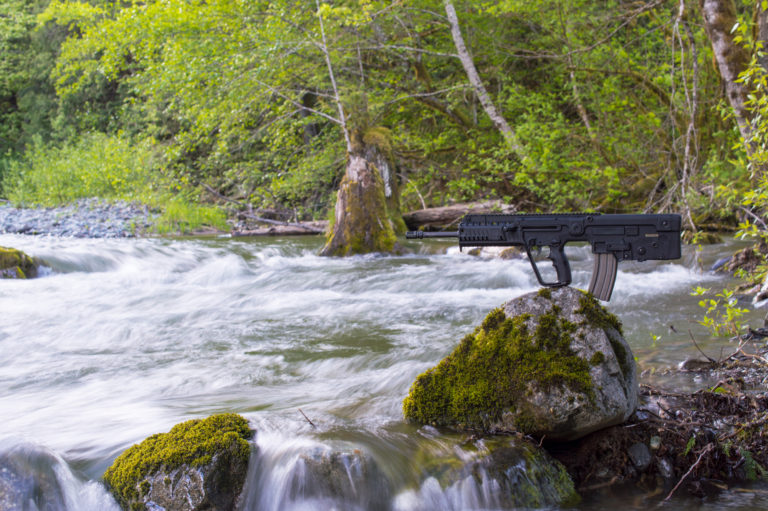
The original Tavor, dubbed the TAR-21, made big news when it arrived in Canada a few years ago. The compact bullpup design, which sets the action back in the stock, reducing the overall size of the rifle for a given barrel length, combined with the non-restricted status for any rifles with a barrel over 470mm, made it a huge hit not only with tactical shooters but with anyone interested in taking light rifles into the field. It took standard AR-15 magazines, it had a track record as a battle-proven service carbine, and it was exotic without giving up a lot of functionality. Shooters lined up to shell out the not-insignificant price, and the Tavor became a Canadian favourite, at least among people who were comfortable shooting multi-thousand-dollar service rifles.
But not everything about the original Tavor was perfectly executed. The trigger was, in a word, awful. The magazine release was poorly designed and required either contortions or letting go of the pistol grip with the firing hand; neither solution was especially appealing. It was an adequate infantry rifle for a country with a conscript army that issues its dedicated shooters M4 carbines. But it wasn't a gunfighter's gun, nor did it excel in competition as some Canadian shooters discovered: the slow magazine changes and poor trigger were just too much of a disadvantage.

And it's taken some time to get the X95 into Canada. User requirements included, aside from a new trigger and magazine release, a new pistol calibre carbine in 9mm joining the rifle in 5.56mm NATO (although the 9mm is as yet unavailable in Canada), the ability to mount suppressors as necessary, and better ergonomics overall. The updates were made and, eventually, the new X95 wound its way through Canada's byzantine and arbitrary classification system and into stores, upgrades ready for testing.

And what about the magazine release? The original was in almost the worst spot we could think of (we kept being told to just hit it with the back of our firing hand, but there is something about letting off our primary grip and then quickly reacquiring it on a pistol grip with a fully exposed trigger that makes us really uncomfortable) and we're happy to say that enough people at IWI agreed that it's been replaced with a conventional pushbutton, much like an AR-15.

Well, if you give us a more compact version of a popular rifle, with the two biggest flaws addressed and some bonus features, what's not to like?
Okay, we'll admit that opinions of Calibre staff were somewhat divided at first. One esteemed member of the team, recently seen luxuriating in the company of the superlative Anschutz 1771, fairly sniffed at the lack of checkered, figured walnut before retreating with his pipe into an overstuffed leather armchair with a snifter of brandy; another promptly denounced the bullpup as an inefficient fighting platform, then flung Arc'teryx LEAF catalogues at us and did kettlebell exercises until we felt uncomfortable and left. There was only one way to settle this: At the range, with eleven different types of ammunition.

The results we got were not at all what we expected.
Now let's start by saying most people have a fairly distorted idea of how accurate rifles usually are, because on the internet, everyone claims to shoot cloverleaf groups at any distance they want. Furthermore, it happens to be that the most popular carbine in the western world, the AR-15, lends itself extraordinarily well to tuning for accuracy, and most of us are used to seeing free-floated barrels, often fairly thick and relatively short, which makes them extremely rigid. The X95, on the other hand, has a barrel that's longer than a typical AR these days, definitely not free-floated, with its teflon sleeve near the rear of the barrel and “stabilizing sleeve” further forward. We'd heard people saying 3-4 minutes of angle (MOA) but given most shooters' rather optimistic take on accuracy, and the fact that a lot of bulk ammunition itself isn't actually capable of printing much better than two or three inches at 100 yards, we thought that we might be looking at a five to six MOA gun.

The best cheap bulk ammo was Aguila 55 grain, at 2.26 MOA, followed by Remington Freedom Bucket 55 grain, at 2.38 MOA. That's about as good as you can expect from bulk .223. But some of the premium ammo got really impressive results, given the limitations of the platform: Barnes Precision Match was just under 2 MOA, Remington Premier Match 1.88 MOA, and Remington Premier Accutip an astonishing 1.49 MOA, although strangely the point of aim/point of impact of the Accutip ammo was significantly different than every other ammo; while extremely repeatable and precise, it shot 2 MOA to the right of every other bullet.


The integral picatinny rails under the handguard, with integrated rail covers that slide off when you press on a little lever-tab, are pretty slick. It's a compact, handy rifle that needs nothing but whatever optic you want. It's got a 1:7 twist, chrome lined, cold hammer forged barrel, and it's non-restricted so you can take it wherever you want. It can be set up for left or right handed shooters, and it's definitely a fun gun.
The X95 isn't cheap, retailing for around $2700, but then restricted AR-15s with a similar pedigree aren't really much below two grand, and they're range toys only.

Certainly, this rifle is not without quirks and we suspect some people will be put off by them enough that they don't think it's worth the ticket price. But if you're looking for a bullpup in Canada, or just the most compact, non-restricted, battle-tested .223 you can get, the X95 is your huckleberry.